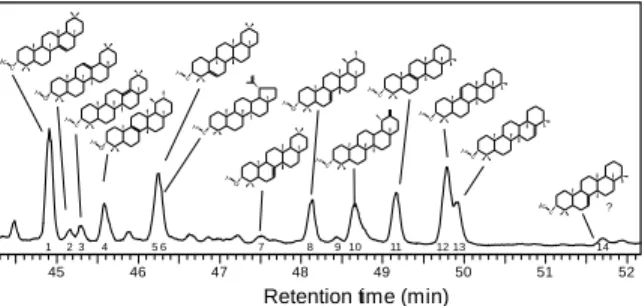HAL Id: insu-00864226
https://hal-insu.archives-ouvertes.fr/insu-00864226
Submitted on 20 Sep 2013HAL is a multi-disciplinary open access
archive for the deposit and dissemination of sci-entific research documents, whether they are pub-lished or not. The documents may come from teaching and research institutions in France or abroad, or from public or private research centers.
L’archive ouverte pluridisciplinaire HAL, est destinée au dépôt et à la diffusion de documents scientifiques de niveau recherche, publiés ou non, émanant des établissements d’enseignement et de recherche français ou étrangers, des laboratoires publics ou privés.
First detection of triterpenyl acetates in soils: sources
and potential as new palaeoenvironmental biomarkers
Marlène Lavrieux, Jérémy Jacob, Claude Le Milbeau, Jean-Robert Disnar,
Renata Zocatelli, Jean-Gabriel Bréhéret, Kazuo Masuda
To cite this version:
Marlène Lavrieux, Jérémy Jacob, Claude Le Milbeau, Jean-Robert Disnar, Renata Zocatelli, et al.. First detection of triterpenyl acetates in soils: sources and potential as new palaeoenvironmental biomarkers. IMOG : The 25th International Meeting on Organic Geochemistry’s, Sep 2011, Interlaken, Switzerland. 3p. �insu-00864226�
First detection of triterpenyl acetates in soils: sources and potential as new palaeoenvironmental biomarkers
Marlène Lavrieux1,2, Jérémy Jacob1, Claude Le Milbeau1, Jean-Robert Disnar1, Renata
Zocatelli1, Jean-Gabriel Bréheret2, Kazuo Masuda3
1 Institut des Sciences de la Terre d’Orléans (ISTO), Université d’Orléans, CNRS/INSU, Université de Tours,
UMR 6113, Orléans, France,
2 Institut des Sciences de la Terre d’Orléans (ISTO), Université de Tours, CNRS/INSU, Université d’Orléans, UMR 6113, Tours, France,
3 Laboratory of Phytochemistry, Showa
Pharmaceutical University, Machida, Tōkyō, Japan (corresponding author:marlene.lavrieux@etu.univtours. fr)
Understanding past reactions of ecosystems under natural and anthropic constraints is of crucial importance to anticipate the consequences of the current global changes. Unraveling natural and anthropic impacts on environments requires the reconstruction of ancient land-uses. As a part of a larger project aiming at developing new molecular biomarkers in soils that could be specific of their overlying vegetation, we have analyzed the neutral lipid content of soils developed under distinct types of plants. Soils were sampled around Lake Aydat, in Central France, of which the catchment is covered with pastures/meadows, forests and moors. The ketone/ester lipid fraction from soils under pastures or meadows contains a series of 14 pentacyclic triterpenyl acetates with a large structural diversity (Fig. 1).
This discovery motivated an extensive phytochemical literature survey (240 references) that showed restricted potential sources of triterpenyl acetates. -amyrin, taraxeryl, glutinyl, -amyrin, and multiflorenyl, acetates are found in very distinct taxa and are thus poorly informative. Conversely, lupeyl, bauerenyl, isobauerenyl, taraxasteryl and -taraxasteryl acetates appear more specific since they are majoritary reported in Asteraceae. Pichierenyl, isopichierenyl and gammacerenyl
acetates seem to be the more specific ones since they are produced by a single known species, Picris hieracioides L. (hawkweed oxtongue, Asteraceae).
Then, we investigated the possible local plants that could have produced the triterpenyl acetates found in the soils of Lake Aydat catchment. 97 Asteraceae species are reported in the area [1], 8 being known as triterpenyl acetate producers. Combined together, these 8 species can explain the diversity of compounds observed in soils, except for glutinyl and swertenyl acetates. These two compounds could either result from the diagenesis of other compounds or could be produced by a yet unknown biological source. To our knowledge, our work constitutes the first report on acetates of bauerane and taraxastane types in geosystems. Our compilation of data also brings original insights into chemotaxonomical relationships with Asteraceae.
Asteraceae are particularly adapted to anthropized environments and rubble [1], but are more generally defined as meadows and pasture species (semi-open to open habitats), appreciating colonizing disrupted environments and able to conquer arable lands lied fallow [2], [3]. Considering the restricted ecological requirements of this family and the ability of pentacyclic triterpenes to survive in geosystems, these new higher plant specific biomarkers could be of direct relevance for the characterization of semi-open to open habitats resulting from anthropic disturbances.
45 46 47 48 49 50 51 52
Retention time (min)
1 23 4 56 7 8 910 11 1213 14
?
Figure 1: GC-MS Total Ion Chromatogram (TIC) showing the distribution of triterpenyl acetates (with the corresponding
structures) in the ketone/ester fraction from the lipid extract of a grassland soil from the Lake Aydat catchment). 1: Taraxeryl acetate (Taraxer-14-en-3-yl acetate); 2: -Amyrin acetate (Olean-12-en-3-yl acetate); 3: -Amyrin acetate (Olean-13(18)-en-3-yl acetate); 4: Isobauerenyl acetate (Bauer-8-en-3-yl acetate); 5: Glutinyl acetate (Glutin-5-en-3-yl acetate); 6: Lupeyl acetate (Lup-20(29)-en-3-yl acetate); 7: Multiflorenyl acetate (Multiflor-7-en3-yl acetate); 8: Bauerenyl acetate (Bauer-7-en-3-yl acetate); 9: -Taraxasteryl acetate (Taraxast-20-en-3-yl acetate); 10: Taraxasteryl acetate (Taraxast-20(30)-en-3-yl
acetate); 11: Isopichierenyl
acetate (Pichier-8-en-3-yl acetate) – tentative identification; 12 Pichierenyl acetate (Pichier-9(11)-en-3-yl acetate); 13: Gammacerenyl acetate (Gammacer-16-en-3-yl acetate); 14: Swertenyl acetate (Pichier-7-en-3-yl acetate).
References
[1] Antonetti, P., Brugel, E., Kessler, F., Barbe, J.P., Tort, M., 2006. Atlas de la Flore d’Auvergne. Conservatoire botanique national du Massif Central, 981 pp.
[2] Cronquist A., Vascular Flora of the Southeastern United States. Volume 1: Asteraceae. 1980, 276 p.
[3] Bouby, L., Billaud, Y., 2005. Identifying prehistoric collected wild plants: a case study from Late Bronze Age settlements in the French Alps (Grésine, Bourget Lake,
Savoie). Economic
